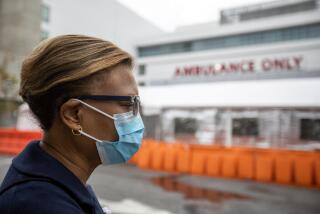Threat Seen as Medicare Profits Dip : Hospitals May Have to Cut Care for Elderly, Officials Warn
- Share via
WASHINGTON — Hospital profits from the treatment of Medicare patients are declining rapidly, potentially threatening the quality of health care for the elderly, government and industry officials warned Tuesday.
Although hospitals are providing good quality care now, they soon will be pressed into cost “damage control” and the nation will have to “decide on the lowest common denominator of acceptable health care,” said Dr. Thomas G. Dehn, president of the American Medical Peer Review Assn., whose members have government contracts to monitor Medicare services.
Under the federal system of fixed payments for treatments received by Medicare patients, about a third of all hospitals will lose money this year on patients over 65, said Dr. Donald Young, executive director of the Prospective Payment Commission, which advises Congress on hospital payment rates. The elderly and the handicapped compose the 32 million beneficiaries of the federal program.
Expenses Climbing
Although federal outlays for Medicare reimbursements to hospitals are strictly controlled, the hospitals’ expenses keep climbing, Young told the House Aging Committee. The average hospital’s profit margin for Medicare patients has plunged from 14% in 1985 and 1986 to 2% last year, and is expected to become a loss this year.
“Forcing hospitals and other providers to lose money on Medicare patients threatens the viability of a weakened and incomplete system for ensuring adequate health care,” said Rep. Edward Roybal (D-Los Angeles), the committee chairman.
The committee is studying the effect of the fixed-fee system, established in 1983, on the quality of care that Medicare patients are receiving. Some officials are pressing for large increases in the federal schedule of treatment fees, while others blame hospitals for failing to lower their costs through improved efficiency.
Premiums Raised
The hospitalization reimbursement is subsidized through payroll taxes, and it is adjusted modestly each year for inflation. Earlier this year, Medicare insurance premiums, which pay for the separate portion of the program that covers doctors’ bills, were raised a record 38% because of spiraling costs.
“We simply do not understand why costs continue to rise so rapidly,” Young said of the hospitals’ finances. “The decline in admissions and the presence of sicker patients do not completely explain the increasing costs. We need to ask whether hospitals and their physicians can’t do a better job of managing their resources without impinging on the quality of patient care.”
The experts agreed that the fixed-fee system had been effective in preventing the federal Medicare trust fund, which disburses the payments for hospital costs, from becoming insolvent. The fund will have sufficient money until the year 2005 to pay expected costs without requiring a new increase in the payroll tax. However, hospitals have been pressed hard by the limits.
Nursing Shortage
“We are treating sicker patients and we’ve got less money and the nursing shortage makes it worse,” said Jack Owen, executive vice president of the American Hospital Assn.
In the future, he said, “An insidious kind of rationing will take place; we will not have the money we need to take the best care of patients.”
Inflation for medical equipment, supplies and services has risen 19% in the last five years, but the federal government’s allowances to hospitals have climbed only 9%. The curb on Medicare payments is “just one indicator that the federal government may have cut into the heart of an already shredded safety net protecting the elderly, disabled and poor,” Roybal said.
Additional Medicare program savings were prescribed in the deficit reduction agreement reached last year between the Reagan Administration and Congress. And there have been persistent reports that the Administration will seek further savings in the fiscal 1989 budget to be unveiled Thursday.
Smaller Hospitals Hit
Officials said that the financial burden falls unevenly on hospitals, with the smaller, rural institutions likely to suffer most. They are less likely to have the staff specialists and high-technology equipment that can greatly accelerate a patient’s treatment and release.
Urban hospitals, for example, had an average profit rate of 10.8% on Medicare cases, while rural hospitals showed an average loss of 0.7%, Richard Kusserow, inspector general of the Health and Human Services Department, told the committee.
He suggested that profit margins could be cut at teaching hospitals, which are generally large institutions in major metropolitan areas, with some of the savings transferred to rural hospitals.
More to Read
Sign up for Essential California
The most important California stories and recommendations in your inbox every morning.
You may occasionally receive promotional content from the Los Angeles Times.













